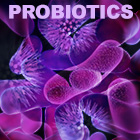THE INNER ECOSYSTEM
 POLYDOPHILUS + FOS contains six species from a wide spectrum of all the important Lactobacilli and Bifidobacteria genera. Dr. Brochu selected a synergistic group of strains that would not be in competition with each other. Mixed strain formulas are not only more economical but more convenient than single strain products. (Yasu Kawai, et al. found that supplying multiple genera of lactic acid bacteria together facilitates their implantation ( Microbiol Immun. 26 (5): 363-73, 1983).
POLYDOPHILUS + FOS contains six species from a wide spectrum of all the important Lactobacilli and Bifidobacteria genera. Dr. Brochu selected a synergistic group of strains that would not be in competition with each other. Mixed strain formulas are not only more economical but more convenient than single strain products. (Yasu Kawai, et al. found that supplying multiple genera of lactic acid bacteria together facilitates their implantation ( Microbiol Immun. 26 (5): 363-73, 1983).
Dr. Brochu has stated, quite simply, “It seems more logical to supply the intestinal tract and vagina with a mixture of specific lactic species rather than using a single species.” Claims that certain species cannot and should not be mixed are sometimes self-serving and always untrue.
POLYDOPHILUS + FOS alters the bacterial profile of the intestines by increasing their content of the following friendly flora:
1) L. Rhamnosus R049 – This strain is superior in many ways: In the report of the Taxonomic Subcommittee, L. rhamnosus shows the greatest ability of all lactobacteria to survive stomach and bile acids next to L. plantarum. It can withstand 30-40% bile acids and provides over 10 times the survivability of L acidophilus. L. rhamnosus is also capable of manganese-catalyzed scavenging of superoxide. Other characteristics of L. rhamnosus as compared to L. acidophilus are:
- 8-10 times as prolific
- Ferments 23 carbohydrates (over twice as many as DDS-1 and NCFM)
- Greater survival to freeze-drying process (75-80% vs. 30-35%)
- Produces L+ lactic acid, which is the natural form in human metabolism and biologically superior to the DL lactic acid produced by L. acidophilus
- Good resistance to antibiotics
- Shows superior results in controlling diarrhea
- Longer shelf life
For some 50 years, many products sold as “acidophilus” were actually rhamnosus. This error was not discovered until new methods of strain and species identification were developed. Rhamnosus was previously classified as a subspecies of L. casei, but has been reclassified as a separate species due to its own unique genetic makeup. Previous studies citing “L. casei” were often subspecies rhamnosus (for example, see Pardigon G. et al. “Systemic augmentation of the immune response in mice feeding fermented milks with Lactobacillus casei and Lactobacillus acidophilus” Immunology 63:17-23, 1988.)
2) L. Plantarum R202 – This is a remarkable species. Being facultative, it survives aerobic (air) and anaerobic (without air) conditions. It ferments 25 carbohydrates, survives salt (10% solution), stomach pH, and bile acids better than any other lactic acid producing organism, and is capable of producing an antioxidant (catalase type) activity. L. plantarum ferments grains, grasses and vegetables and is a normal part of the diet (found in sauerkraut and all types of pickled vegetables.)
3) L. Acidophilus R052 – This proprietary culture of the Roselle Institute is of human origin and was selected by Dr. Brochu because of its ability to ferment 15 carbohydrates into lactic acid rather than 11 typical of this species. Being a hardier strain, L. acidophilus R052 displays superior production and survival than the neotype strain.
4) Bifidobacterium Longum BB536 (Morinaga) – The bifidobacteria are able to digest insoluble dietary fiber into short chain fatty acids which in turn are absorbed and used for energy by the colon cells.
- Implants early in infancy and is found in humans throughout life cycle
- Produces acetic acid along with lactic acid and small amounts of formic acid, which lowers the pH (increases acidity) of the bowel, making the region inhospitable to invading bacteria
- Competes with pathogenic bacteria and yeasts for nutrients and attachment sites
- Ferments over 20 carbohydrates and produces L+ lactic acid
5) Bifidobacterium Breve R070 – B. breve is probably the most common bifidobacteria found in infants, and it is a lifelong resident in the human intestines.
6) L. Casei R256 – L. casei is often used to make fermented milk products and cheeses. It is popular in Japan and has been the subject of research including minor immunological effects in the GI tract including inhibition of pathogens.
OTHER PROPERTIES OF LACTIC-ACID PRODUCING BACTERIA
Dr. Edward Brochu of the Institut Rosell has outlined various nutritional aspects of human intestinal flora:
1) Predigestion of foods by proteolysis, or breaking down proteins to peptides and amino acids.
2) In dairy, the sugar lactose is partially to totally converted to lactic acid. This hinders the proliferation of harmful bacteria: First by depriving the pathogens of the sugar as its food; and second, by presenting the pathogen with lactic acid, hydrogen peroxide and bacteriocins (neutral antibiotic compounds).
3) A slight liberation of fatty acids and solubilization of mineral salts, such as calcium, increasing bioavailability.
4) Probiotic cultures produce certain vitamins, including thiamin, riboflavin, pyridoxine, vitamin K, folic acid, and PABA.
5) In infants, weight gain is enhanced, probably due to predigestion enhancing assimilation.
6) Contribute to intestinal peristalsis (smooth muscle contractions), speeding up bowel evacuation time. The flora acidifies the stool by decreasing the pH from 7-8 to 5-6.
7) The flora coat the intestinal mucosa, protecting against invasion from harmful pathogens.

